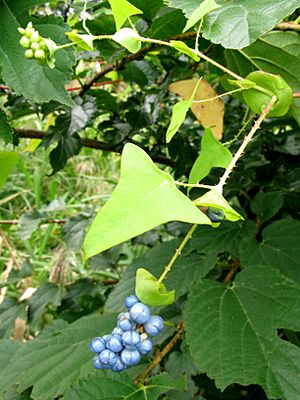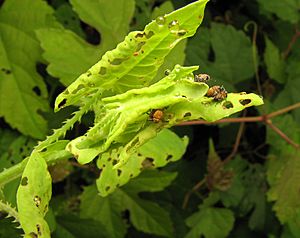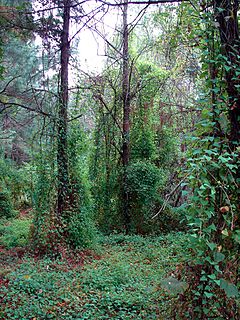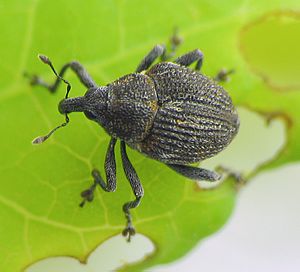Mile-a-minute facts for kids
Quick facts for kids Mile-a-minute |
|
|---|---|
 |
|
| Scientific classification | |
| Synonyms | |
|
Persicaria perfoliata is a fascinating plant with many common names like mile-a-minute and devil's tail. It's a type of flowering plant in the buckwheat family. This plant is an annual vine, meaning it grows and dies within one year. It has stems with tiny hooks and leaves shaped like triangles.
This plant originally comes from eastern Asia, including places like Russia, Japan, the Philippines, and India. However, it has become an invasive weed in other parts of the world. This means it grows very quickly and can take over areas, harming local plants.
In Europe, Persicaria perfoliata is on a special list of "Invasive Alien Species." This means people are not allowed to bring it in, grow it, or sell it in the European Union. This rule helps protect the environment from this fast-spreading plant.
Contents
What Does Mile-a-Minute Look Like?
Persicaria perfoliata has reddish stems covered with small, downward-pointing hooks. These hooks are also found on the underside of its leaves. The leaves are light green and shaped like an equal-sided triangle. They grow one after another along the thin, delicate stems.
A unique feature of this plant is its circular, cup-shaped leafy structures called ochreas. These ochreas wrap around the stem at regular spots. Flower buds, and later small, white flowers and fruits, grow from inside these ochreas. The fruits are very pretty, looking metallic blue and segmented. Each part of the fruit holds a single shiny, black or reddish-black seed.
Where Does Mile-a-Minute Grow?
Persicaria perfoliata loves warm, open places. You can often find it along the edges of woods, in wetlands, near stream banks, and along roadsides. It also grows in open fields that are not farmed, whether they became open naturally or because of human activity. It can even be found in dense wooded areas where the tree cover has opened up, allowing more sunlight to reach the forest floor.
Places like stream banks, parks, open spaces, road shoulders, forest edges, and fence lines are common spots for this plant. It can even survive in very wet areas with poor soil.
Sunlight and soil moisture are very important for this plant to grow well. It can handle some shade during the day, but it needs a lot of sunlight, usually 63% to 100% of the available light. A key to its survival is its ability to use its hooked barbs to attach to other plants and climb over them. This helps it reach areas with lots of light. While it can live in drier soils, it prefers soil that is very moist.
Can You Eat Mile-a-Minute?
Yes, Persicaria perfoliata is an edible plant! Its young leaves and shoots can be eaten raw, like in a salad, or cooked as a vegetable. The fruits are sweet and can be eaten fresh.
How Is Mile-a-Minute Used?
In traditional Chinese medicine, Persicaria perfoliata is known as gangbangui (Chinese: 杠板归; pinyin: gāngbǎngūi). People believe it can be used for various remedies in herbal medicine. Besides medicine, the plant can also be used to make fiber or ropes.
How Mile-a-Minute Came to the United States
The first times Persicaria perfoliata was seen in North America were in Portland, Oregon (1890), and Beltsville, Maryland (1937). However, these early plants did not stay or create lasting populations. The plant truly became established in the wild sometime between the late 1930s and 1946. This happened at a plant nursery in Stewartstown, York County, Pennsylvania. It's thought that the seeds spread with Rhododendron plants.
To control this plant, a special weevil (a type of beetle) called Rhinoncomimus latipes was introduced in the eastern US starting in 2004. This method has had some success in managing the plant's spread.
How Mile-a-Minute Reproduces and Spreads
Persicaria perfoliata mostly pollinates itself. This means it can produce seeds without needing help from insects or other pollinators. Its flowers are small, closed, and don't have much scent, which supports this idea. The plant produces fruits and good seeds on its own. It cannot grow new plants from its roots.
This plant is a tender annual, meaning it dies with the first light frost. It keeps reproducing successfully until that first frost arrives. P. perfoliata produces many seeds on a single plant over a long period, from June to October in Virginia. The season is a bit shorter in colder northern areas. This plant can grow as much as 30 feet (about 9 meters) in just one season, and even more in the southern United States.
Birds are likely the main way P. perfoliata seeds travel long distances. Ants have also been seen carrying seeds short distances. This might be because the seeds have a tiny white food part called an elaiosome that ants find tasty. These seed-carrying ants may help the seeds survive and sprout. Local birds are important for spreading seeds under power lines, near bird feeders, along fence lines, and in other places where birds perch. Other animals like chipmunks, squirrels, and deer have also been seen eating its fruits.
Water is another important way the seeds spread. The fruits can float for 7 to 9 days. This is a big advantage for seeds traveling long distances in streams and rivers. The long vines often hang over waterways, allowing fruits that fall off to be carried away by the water current.
See also
 In Spanish: Persicaria perfoliata para niños
In Spanish: Persicaria perfoliata para niños




